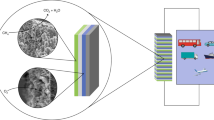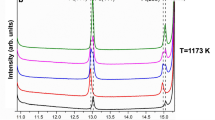Abstract
Fuel cells constitute an attractive power-generation technology that converts chemical energy directly and with high efficiency into electricity while causing little pollution. Most fuel cells require hydrogen as the fuel, but viable near-term applications will need to use the more readily available hydrocarbons, such as methane. Present-day demonstration power plants and planned fuel-cell electric vehicles therefore include a reformer that converts hydrocarbon fuel into hydrogen. Operating fuel cells directly on hydrocarbons would obviously eliminate the need for such a reformer and improve efficiency. In the case of polymer-electrolyte fuel cells, which have been studied for vehicle applications, the direct use of methanol fuel has been reported, but resulted in fuel permeating the electrolyte1,2. Solid oxide fuel cells — promising candidates for stationary power generation — can also use hydrocarbon fuel directly to generate energy, but this mode of operation resulted in either carbon deposition at high temperatures or poor power output at low operating temperatures3,4,5. Here we report the direct electrochemical oxidation of methane in solid oxide fuel cells that generate power densities upto 0.37 W cm−2 at 650 °C. This performance is comparable to that of fuel cells using hydrogen6,7 and is achieved by using ceria-containing anodes and low operating temperatures to avoid carbon deposition. We expect that the incorporation of more advanced cathodes would further improve the performance of our cells, making this solid oxide fuel cell a promising candidate for practical and efficient fuel-cell applications.
This is a preview of subscription content, access via your institution
Access options
Subscribe to this journal
Receive 51 print issues and online access
$199.00 per year
only $3.90 per issue
Buy this article
- Purchase on Springer Link
- Instant access to full article PDF
Prices may be subject to local taxes which are calculated during checkout




Similar content being viewed by others
References
Ren, X., Wilson, M. S. & Gottesfeld, S. High performance direct methanol polymer electrolyte fuel cells. J. Electrochem. Soc. 143, L12–L14 (1996).
Wang, J., Wasmus, S. & Savinell, R. F. Evaluation of ethanol, 1-propanol, and 2-propanol in a direct oxidation polymer-electrolyte fuel cell. A real-time mass spectrometry study. J. Electrochem. Soc. 142, 4218–4224 (1995).
Sfeir, J., Van herle, J. & McEvoy, A. J. in Proc. 3rd European Solid Oxide Fuel Cell Forum (ed. Stevens, P.) 267–276 (European Fuel Cell Forum, Switzerland, 1998).
Putna, E. S., Stubenrauch, J., Vohs, J. M. & Gorte, R. J. Ceria-based anodes for the direct oxidation of methane in solid oxide fuel cells. Langmuir 11, 4832–4837 (1995).
Aida, T., Abudala, A., Ihara, M., Komiyama, H. & Yamada, K. in Proc. 4th Int. Symp. on Solid Oxide Fuel Cells (eds Dokiya, M., Yamamoto, O., Tagawa, H. & Singhal, S. C.) 801–809 (Electrochemical Soc., Pennington, 1995).
Fung, K-Z., Chen, J., Tanner, C. & Virkar, A. V. in Proc. 4th Int. Symp. on Solid Oxide Fuel Cells (eds byDokiya, M., Yamamoto, O., Tagawa, H. & Singhal, S. C.) 1018–1027 (Electrochemical Soc., Pennington, 1995).
Tsai, T. & Barnett, S. A. Increased solid-oxide fuel cell power density using interfacial ceria layers. Solid State Ionics 98, 191–196 (1997).
Janssen, G. J. M., DeJong, J. P. & Huijsmans, J. P. P. in Proc. 2nd European Solid Oxide Fuel Cell Forum (ed. Thorstense, B.) 163–172 (European SOFC Forum, Switzerland, 1996).
Hendriksen, P. V. in Proc. 5th Int. Symp. on Solid Oxide Fuel Cells (eds Stimming, U., Singhal, S. C., Tagawa, H. & Lehnert, W.) 1314–1325 (Electrochemical Soc., Pennington, 1997).
Ray, E. R. in 1992 Fuel Cell Seminar Abstr. (eds Fuel Cell Seminar Committee) 415–418 (Courtesy Associates, Washington, 1992).
Huebner, W., Anderson, H. U., Reed, D. M., Sehlin, S. R. & Deng, X. in Proc. 4th Int. Symp. on Solid Oxide Fuel Cells (eds Dokiya, M., Yamamoto, O., Tagawa, H. & Singhal, S. C.) 696–705 (Electrochemical Soc., Pennington, 1995).
deSouza, S., Visco, S. J. & DeJonghe, L. C. Thin-film solid oxide fuel cell with high performance at low-temperature. Solid State Ionics 98, 57–61 (1997).
Minh, N. Q. in Proc. 4th Int. Symp. on Solid Oxide Fuel Cells (eds Dokiya, M., Yamamoto, O., Tagawa, H. & Singhal, S. C.) 138–145 (Electrochemical Soc., Pennington, 1995).
Godickemeier, M., Sasaki, K. & Gauckler, L. J. in Proc. 4th Int. Symp. on Solid Oxide Fuel Cells (edsDokiya, M., Yamamoto, O., Tagawa, H & Singhal, S. C.) 1072–1081 (Electrochemical Soc., Pennington, 1995).
Tsai, T., Perry, E. & Barnett, S. Low-temperature solid-oxide fuel cells utilizing thin bilayer electrolytes. J. Electrochem. Soc. 144, L130–L132 (1997).
Tsai, T. & Barnett, S. A. Effect of mixed-conducting interfacial layers on solid oxide fuel cell anode performance. J. Electrochem. Soc. 145, 1696–1701 (1998).
Steele, B. C. H., Middleton, P. H. & Rudkin, R. A. Material science aspects of SOFC technology with special reference to anode development. Solid State Ionics 40/41, 388–393 (1990).
Hori, C. E.et al. Thermal stability of oxygen storage properties in a mixed CeO2-ZrO2system. Appl. Catal. B 16, 105–117 (1998).
Acknowledgements
E.P.M. was supported by the Illinois Minority Graduate Incentive Program.
Author information
Authors and Affiliations
Corresponding author
Rights and permissions
About this article
Cite this article
Murray, E., Tsai, T. & Barnett, S. A direct-methane fuel cell with a ceria-based anode. Nature 400, 649–651 (1999). https://doi.org/10.1038/23220
Received:
Accepted:
Issue Date:
DOI: https://doi.org/10.1038/23220
This article is cited by
-
Novel Perovskite Oxide Hybrid Nanofibers Embedded with Nanocatalysts for Highly Efficient and Durable Electrodes in Direct CO2 Electrolysis
Nano-Micro Letters (2024)
-
Preparation and doping modification of cerium oxide photosensitizers applied to photosensitive glass ceramics
Journal of Materials Science: Materials in Electronics (2022)
-
Perovskite Cathode Materials for Low-Temperature Solid Oxide Fuel Cells: Fundamentals to Optimization
Electrochemical Energy Reviews (2022)
-
Comparison of electrochemical impedance spectra for electrolyte-supported solid oxide fuel cells (SOFCs) and protonic ceramic fuel cells (PCFCs)
Scientific Reports (2021)
-
Co-fired anode-supported solid oxide fuel cell for internal reforming of hydrocarbon fuel
Energy, Ecology and Environment (2021)
Comments
By submitting a comment you agree to abide by our Terms and Community Guidelines. If you find something abusive or that does not comply with our terms or guidelines please flag it as inappropriate.



